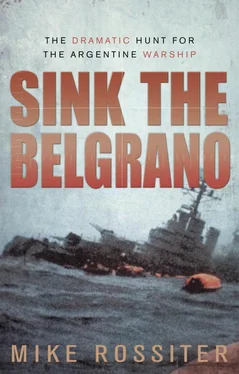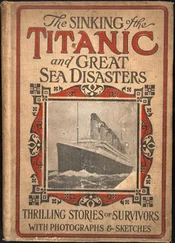Putting nuclear reactors in submarines had turned the battle between surface warships and submarines completely on its head once more. The enormous power available from a nuclear plant transformed the diesel-powered submarines of the Second World War, rendering obsolete the destroyers, frigates and corvettes that had been the stars of convoy protection and which had featured in classic war films like The Cruel Sea . Submarines now had the power easily to outrun not only most surface warships but also the newly developed anti-submarine torpedoes. Nuclear power also meant that the submarine need never again surface while on a patrol. There was more than enough energy available to provide refrigeration for large stocks of food, desalination plants for fresh water, power to heat it for showers and cooking, and power to electrolyse water to provide oxygen and clean air for the crew. The only effective way of locating the presence of a submarine was by detecting the sound that it made as it travelled deep beneath the surface of the ocean. Nuclear submarines like Nautilus could cruise for months on end, the weakest link now being the crew and the limits of their endurance.
The Royal Navy had also started to investigate the use of nuclear reactors for ships and submarines, but was hampered by the type of reactors that Britain’s Atomic Energy Authority was designing for civilian electricity generation. These were heavy, cumbersome gas-cooled reactors and it proved impossible to make them small enough for marine use. By 1953 the navy had started to look at simpler designs, like the pressurized water-cooled reactors being built in the USA; but the launch of Nautilus showed how far in advance of the British were the achievements of the United States navy.
Help was at hand, however. In 1957 the United States offered to share its technology, and supplied a complete marine reactor and power plant to the British government.
Britain’s first nuclear submarine, then, HMS Dreadnought , named in honour of Admiral Fisher’s revolutionary battleship of 1906, was commissioned some years after Nautilus , in April 1963. The front part of the boat had been designed and built in the Vickers shipyard in Barrow-in-Furness, but the nuclear reactor and most of the machinery surrounding it was supplied by the United States. Dreadnought quickly demonstrated what she was capable of, travelling from Rosyth to Singapore and back, a distance of 26,545 miles, submerged.
The next nuclear submarine to be built in Britain, Valiant , was again a product of Vickers shipyards, and this time the nuclear reactor was built and supplied by Rolls-Royce. Valiant was never completely successful, but the designs that followed, of which Conqueror was the fourth in the series, saw increasing improvements in the machinery, hull shape and other technologies. The British designs were aimed at reducing the transmitted noise of the pumps for coolant water and heat exchangers that were a feature of nuclear reactors. The reactor, the steam-generating plant, turbines and gearbox were all placed on a metal raft, which was insulated from the main hull by rubber and hydraulic mountings. The reactors were now wholly designed and built by British companies, and the torpedo tubes were modified to take a modern wire-guided torpedo called Tigerfish.
The next improvement on the design of Conqueror was a new class of submarines, the Swiftsure class, which were faster, could dive deeper, and were equipped with a water-pump propulsion system, which was a multi-bladed propeller inside a casing, rotating between two static sets of blades, like a turbine. This made the rear end of the submarine much quieter. By 1982, five of these submarines had entered service.
The nuclear submarines were used to making rapid responses for extremely hazardous operations. A typical incident, albeit in British waters, involved the Conqueror . She was moored in Faslane on New Year’s Eve 1972 when she was scrambled. Her orders were to trail a ship that was suspected of smuggling guns to the IRA in Northern Ireland and on her return from this task a few weeks later, according to her navigating officer of the time, Roger Lane-Nott, ‘We were in the forefront of the emerging situation with the Russians in the north-east Atlantic.’ A Russian submarine had been detected entering the Atlantic, and was suspected of being in the inner Clyde area.
It was vital to protect the Polaris boat security and we were sent to identify it and chase it off. At the time there was no real system of command and control, and our rules of engagement were just ‘make it go away’. It was left pretty much up to us.
Conqueror found the Russian submarine and confirmed that it was a Victor class. It was harder to know how to persuade the Russian sub to leave: ‘We made close passes, of less than 1,000 yards, using active sonar so he knew we had located him, at speeds of 28 knots.’ The combined speed of the approaching submarines was around 60 miles an hour, and in confined and shallow water, with only sonar to guide them, it is easy to see how an incident like this could result in a deadly collision. The fact that it didn’t was a testament to the ability of the commanding officer and the crewmembers. Nobody was given command of a submarine without passing through a special Submarine Commanding Officer’s Qualifying Course, known as ‘Perisher’ because during the course so many submariners’ hopes of command perished. But it produced submarine commanders who had been exposed to extremely stressful situations, and who were supremely confident of their abilities. They also knew what their submarine and its equipment was capable of doing. Conqueror eventually persuaded the Soviet submarine captain to leave, but this incident exposed the lack of a proper command and control system. In the year following this encounter, the control of both Polaris and hunter-killer submarines was centralized in the NATO headquarters in Northwood, a suburb of north London.
In the light of Conqueror ’s previous missions, then, an urgent telephone call to the duty officer of a submarine tied up in harbour was not out of the ordinary, but the order that came on 30 March 1982 to ‘store for war’ certainly was. Commander David Hall was extremely concerned. Conqueror had completed a lengthy patrol in the Barents Sea before crossing the Atlantic to the undersea exercise area in the Bahamas. The submarine was now in its tenth year of service and badly needed a period in port for maintenance. Commander Hall’s team had already started work on the reactor control equipment and the main propulsion machinery, some of which was already in pieces. Petty Officer Charlie Foy, who was living on the boat, remembers that a lot of the equipment had already been removed to the shore to be stripped down and cleaned. They now had to reverse this process, and quickly.
The first task was to get the remaining officers and crew back from leave and then work out the best way to shorten a planned five-week maintenance programme. The navigating officer, Lieutenant Jonathan (Jonty) Powis, was living in Faslane with his wife, who was expecting a baby in May. He quickly returned to the boat and started to prepare a list of crewmembers and their contact details. Some of the officers had already been telephoned by the Faslane duty operations officer. Lieutenant Commander Tim McClement, Conqueror ’s second in command, had left Faslane the day before.
I got into the car with my wife and my six-month-old baby and we drove all the way down to Bath to meet my parents, who we were going to spend Easter with. We arrived, of course, and the first thing my father said was, ‘Your officer of the day has been on the phone – you’ve got to go back.’ And I said, ‘Well, I’m too tired – I’ve just driven all the way down.’ So I went to bed for four hours, then left my wife and my son, borrowed my mother’s car and drove myself all the way back. I assumed we were being deployed as the northerly boat. And I just left my wife and young baby.
Читать дальше












